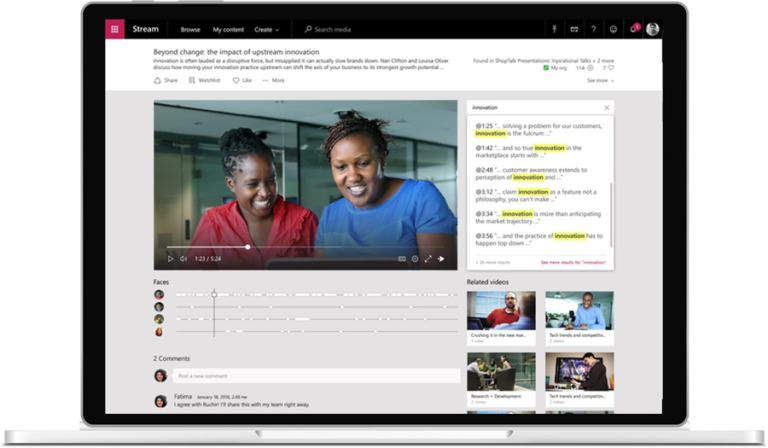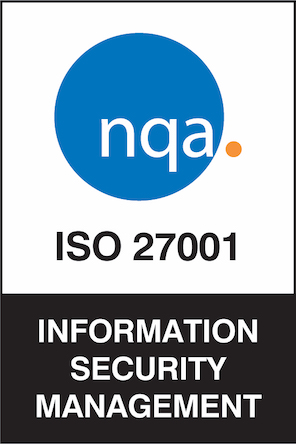Microsoft Yammer, at first glance, can be confusing to those unfamiliar with the platform. It seems to bring together the communication capabilities of Teams with the company-wide news dashboard features of SharePoint. It’s when you take a closer look into what it has to offer, that you find that it fits its own niche very well—providing companies with a unique and dependable platform for employee engagement. Best of all, its integration with the Office 365’s suite of enterprise products makes it much more than the sum of its parts.
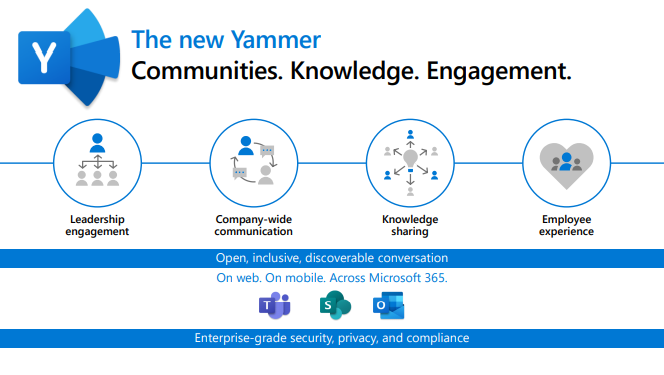

Microsoft Yammer: Guiding Principles
Before we delve deeper into what else Microsoft Yammer has to offer, it’s important that we understand the main principles that guide the move towards a newer version—as well as the key areas of focus and emphasis. There are three concepts that guide the recreation of Yammer: communities, knowledge, and engagement. A lot of the changes are guided in the quest to strengthen these three principles.
It’s no surprise, of course, that these three are currently dominant in the enterprise. What Microsoft Yammer aims to empower is the development of communities within companies that drive culture and proactive action among colleagues. Within these communities, the platform aims to promote easy knowledge sharing internally. Ultimately, all of these elements create a deeper sense of employee engagement and a richer employee experience.
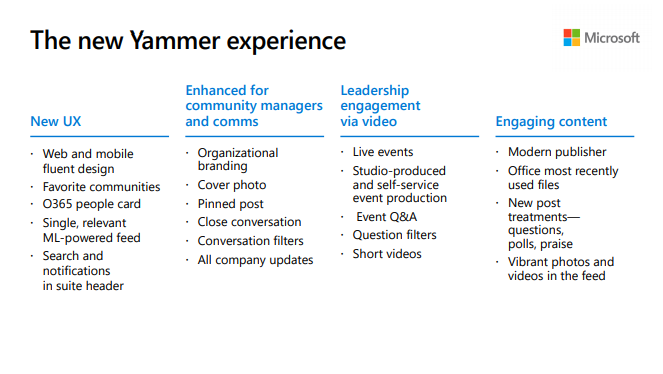

On a more practical level, these principles are also reflected in the cross-platform compatibility that Microsoft Yammer now strives for—not just with different Office 365 programs and applications, but also access points . As of this writing, much of the changes can be seen in the web versions of applications—such as with Outlook—but the design team has already said that a roll-out towards mobile and desktop applications is currently in the works.
They have also recently released a standalone Teams integration called Communities, which lets users have a fully interactive Yammer experience natively interact with Yammer directly from the popular collaboration platform.
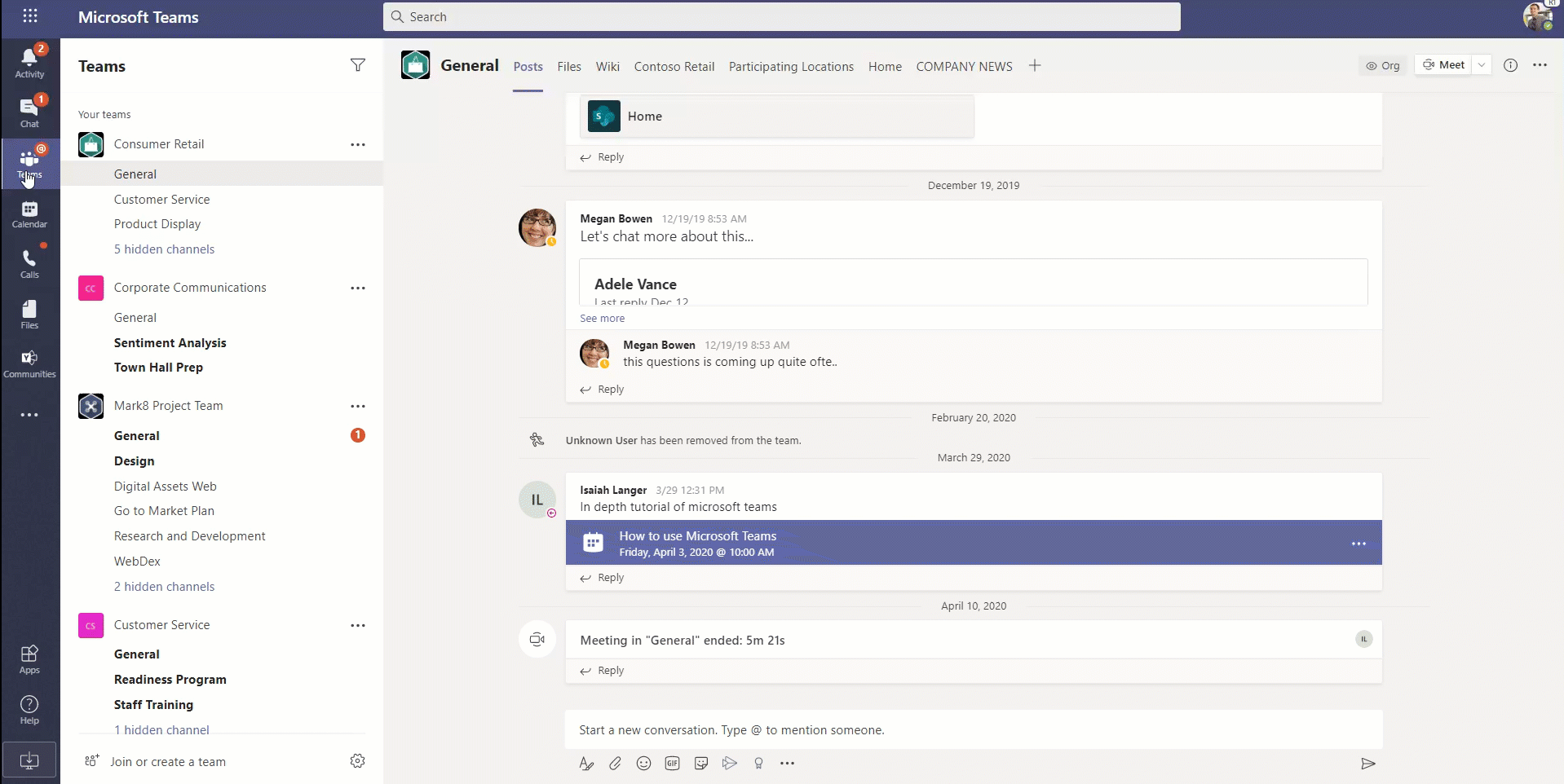

Social Media With a Twist of Enterprise
Its own designers have billed it as an “enterprise social tool for community sharing” which is essentially social media for businesses. The closest comparison to an already familiar platform would be Workplace from Facebook. With the overhaul of the platform first being announced towards the end of last year, the similarities to Workplace from Facebook are striking. Just as a key component of Workplace from Facebook’s success is its familiarity, Yammer is treading the same path to good effect with a fresh focus on user experience.
For one thing, interacting with posts and announcements throws up options for rich text formatting. This allows users to put emphasis on responses however they see fit with options for bold, italic, and underlines. GIFs are easy to share with an embedded carousel to choose from. Perhaps the strongest feature is a dropdown highlighting your recent work on Word, Excel and even PowerPoint which you can readily share to any relevant thread or post.
All of these are presented in what Microsoft Yammer calls “social cards”. It’s a subtle but integral design choice that ties directly to the aim of cross-platform compatibility. Each post is an entity unto itself. When shared via Teams and even Outlook, they look and act exactly as they would were they viewed in Yammer. It’s a critical feature that enables users who are more deeply embedded and involved with other Office 365 programs to enjoy full functionality as though they were viewing it directly on Yammer.
Enhanced Features for an Enhanced Experience
The features mentioned above are found within competitor software, but there is also a whole stack of new features unique to this new version of Microsoft Yammer itself. First among these is the Office 365 People Card. These are the equivalent of profiles in other social media and are tied directly to users added into your organisation Active Directory. These are useful for situating a person as they show where they sit in the hierarchy, who they collaborate with, events that you share with that person, and even messages and files shared between the two of you.
Another great innovation resulted from listening to their customer’s requests. The new Yammer now features AI curation when it comes to content in the feed. What it does is to filter and prioritise the content you see based on what is relevant to your job role, your position, and your interests so that they’re top of the screen. This adds a layer of relevance to what you get before you each time you check Yammer. This also applies to what is delivered to your Outlook inbox should you enable such notifications.
Other improvements sourced from users include improvements to the community section. For one, there’s the ability to post a cover photo to a community page. This can be used to better brand and can even be used to keep key announcements front and centre. Conversations too can be pinned within communities for above the fold attention — especially useful with key discussions. Within these conversations, users have the same rich options to customize responses as they do with social cards.
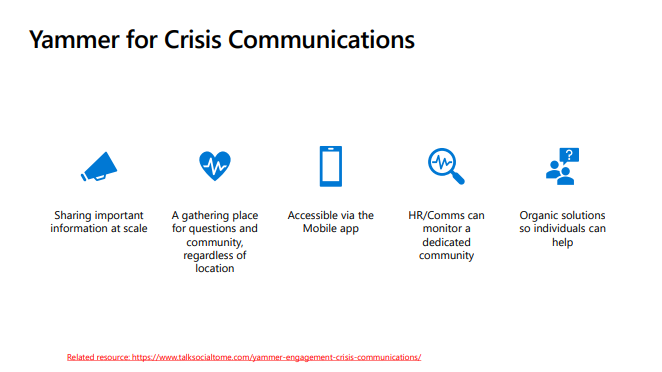

Microsoft Yammer in a Crisis
In times of crisis communications take centre stage in maintaining order amid the fear and uncertainty that can easily spread. Microsoft Yammer has acknowledged the critical role it plays and has incorporated crisis thinking into its reinvigoration of the platform. Empowerment is the name of the game and the platform allows for key information sharing at scale.
The ‘communities’ within Microsoft Yammer form an effective and safe gathering place for the fielding and answering of key questions and answers before, during, and after a crisis — regardless of where your employees and your HR/Comms personnel are located. The relative ease-of-use and simplicity of the platform make it easy to monitor, and the built-in AI makes focusing on common, critical issues so much easier—including mobile accessibility.
When Hurricane Irma ravaged the United States in 2017, Johnson & Johnson utilized Microsoft Yammer among other platforms. In particular, Yammer was used to create a community to facilitate communications with affected employees — even those employees that opened their homes to displaced members of the public. Key documents and files were also easily shared to employees and stakeholders. Yammer was also used by their senior leadership to talk directly to their employees and take charge of the situation.
Johnson & Johnson’s Employee Home Share initiative was a success – in part – because of Microsoft Yammer, and the team was quick to point out the simplicity of utilizing the system as a cornerstone of success. It allowed the creation of a centralized, global, and wholly online safe haven for their people. The company came out of the crisis relatively unscathed and much stronger for it. A culture of caring and mutual support emerged from the crisis revolving around the platform.
Outlook Integration Explored
Based on their own internal research, Microsoft has found that Outlook is still its most widely used service. After all, email remains relevant to employees and employers the world over. At present, in its web version, Microsoft has empowered Outlook users with a Microsoft Yammer integration that can be best described as near-native. Posts and announcements, as we already mentioned, appear exactly as they would if they were viewed in Yammer.
How you interact with the post is completely the same as what you get in the Yammer application also. For example, viewing images on a post throws up a pop-out gallery that you can scroll through. When checking on who liked or interacted with an announcement, a slider pops up from the right listing the information. You can like, respond, and even mark ‘best’ answers for reference. Polls created in Microsoft Yammer and shared to Outlook can be acted upon and monitored in real-time.
On top of that, you can easily shift to the classic, standard email view should you want to share an announcement or poll to anyone else in the ecosystem. One great feature that works in the background is that analytics work regardless of whether engagement was through Microsoft Yammer or Outlook. This makes it easy and accurate to track key data points that guide communications planning. Again, it’s on the web version for now, but they’re looking to roll it out to the mobile and desktop versions of Outlook come April to June of this year.
Microsoft Yammer Leverages the Power of Video
A study by the Academy to Innovate HR (AIHR) has found that employees are more likely to recall and retain over 95% of any particular message when it comes at them in video format. That same study has found that a whopping 93% of internal communication experts consider video to be a key tool in their arsenal. On the other side of the coin, 59% of those in senior leadership prefer watching video content over reading it in text format.
A Study in Effectiveness
It’s really a clear trend, especially on social media, with many companies and even news outlets pushing out video content for their key releases over any other — both internally and externally. One great example of this is the Alzheimer’s Society. They pushed out a new five-year plan via the launch of their own internal TV channel. This channel featured a film that expertly explained the key policy changes on top of explaining why the changes mattered. It was very successful among their 2,500 employees as well as their 9,000 volunteers.
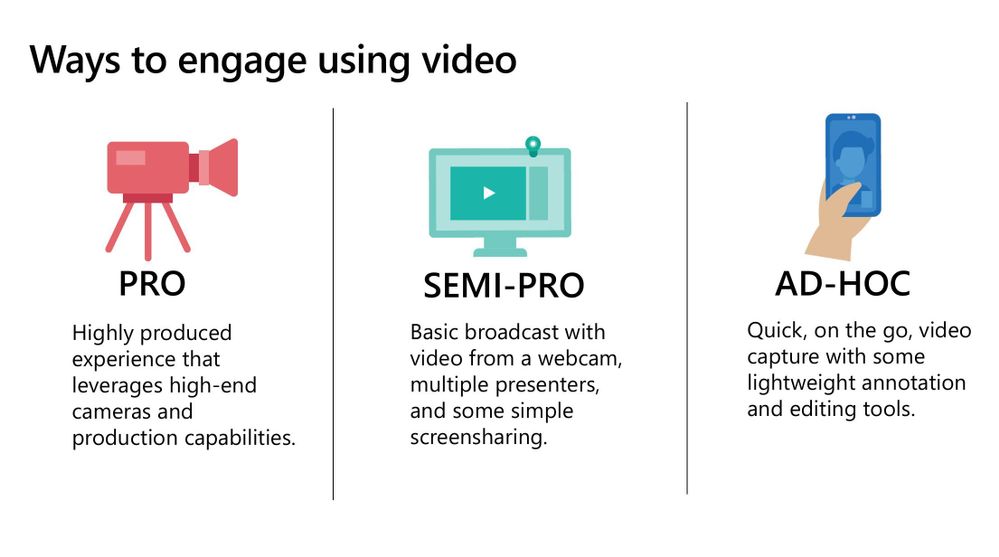

The Video Advantage Applied
For Microsoft Yammer and its design team, their goals in improving video capabilities within the platform include building trust and authenticity in their leaders, meaningful information dissemination, and full employee engagement towards the company vision. Towards those ends, they focused their work on optimizing their work-flow through every event cycle’s natural touchpoints. All this through a platform that supports everything from professional on-site productions, semi-professional broadcasts from anywhere, and even ad-hoc mobile videos as would be the case with some executive blogs.
Professional videos are those that result in high-quality output as is the case with explainer videos, roundtable discussions, town halls and the like. Semi-professional options include coverage in the field — as would be the case in product launches or new office openings. Finally, ad-hoc can be as simple as the CEO sharing his thoughts and opinions casually and on-the-go. While each has value on its own—they can come together in a natural flow to push a full-fledged campaign.
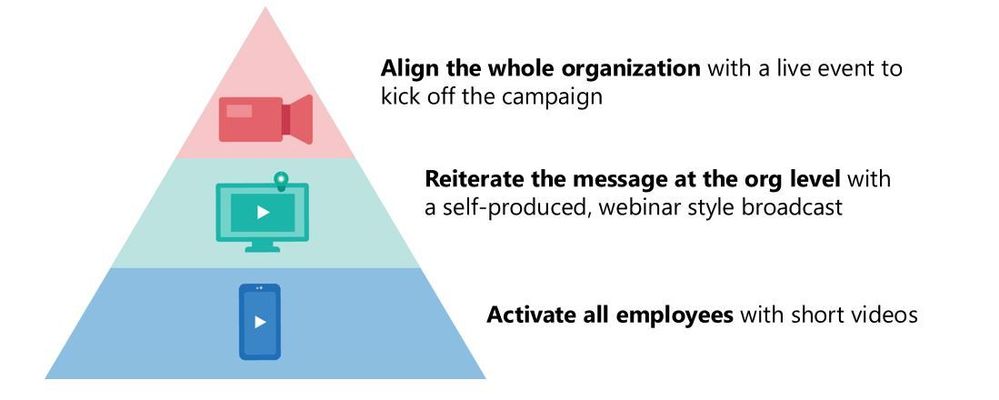

An Example in Action
Say you wanted to run an outreach program where employees reach out to local kids to help teach them how to read. A professional video can be created to get the whole company aligned with the ideals of the program. You could even go for a live event set up for launch. At the organizational level—with the use of semi-professional setups like webinars or even local live videos—you can then reinforce the message or go deeper with tutorials on the most effective techniques for teaching reading.
Ad hoc videos can then be those on the ground—employee-made videos showing them and their experiences with the kids that they teach. Or even videos where they share their experiences and emotions as they undergo a program. There really is no need to have each tier mutually exclusive. They, in fact, work best in support of one another. That’s just one example. The central idea behind videos on Microsoft Yammer is to create meaningful connections that facilitate shared knowledge.
Towards that end, Yammer can be used to host webinars that are crafted and launched in Microsoft Teams. It’s currently set for internal users only, which makes it a powerful tool for internal comms efforts. A great thing about webinars set up through Teams and funnelled through Microsoft Yammer is that it enables for deeper engagement via company-wide chat and comments. All of the video content is stored in Microsoft Stream for easy access. Note the mobile videos are still stored in SharePoint for the moment — something that their team is looking to fix in the future.
Microsoft Yammer Compliance and Security
A final point worth looking at with the rollout of the new Microsoft Yammer are its compliance and security measures. A lot of these new integrations are to run parallel to Office 365’s existing Security and Compliance Centres. These improvements centre around Native Mode. This includes the assignment to one Tenant to one Yammer set up. It also implies that users are mapped in Azure’s Active Directory, that all groups created are connected to a single Office 365 Group, and that — eventually — all Yammer files will be stored in SharePoint.
Another important aspect worth touching on is smarter eDiscovery. Integration with Microsoft Yammer means that you can not only search by user and view their full Office 365 profile, but all their messages through Yammer are now visible alongside any others that they have sent via other platforms. These messages can be filtered based on key parameters like author, recipient, and even community. This makes it far easier to search for content as needed.
Lastly, minimum and maximum data retention parameters will also feature in the newest iteration of Microsoft Yammer. Users will have two options when getting rid of content. Archive mode will put things away into long-term storage. Delete mode will completely erase content after 30 days’ time. Also, it is important to note that deleting any groups will then result in the deletion of messages therein. All this allows finer control over the lifecycle of your content.
A New Microsoft Yammer for the Future
All of these changes represent not just the future of Microsoft Yammer, but also Microsoft’s commitment to integrating features that its user base has long clamoured for. It’s a promising move for a platform that seeks to fulfil a popular comms niche in today’s world from within Office 365’s already impressive Enterprise Suite.








